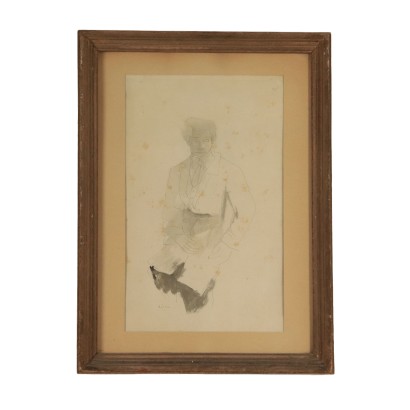Drawing Attributed to Marino Marini Male Figure 1928 - Male figure,1928
Features
Artist: Marino Marini (1901-1980) Attributable to
Artwork title: Figura maschile
Age: Contemporary
Subject: Human Figures
Artistic technique: Drawing
Technical specification: Mixed Technique
Description : Figura maschile
Mixed technique on paper. Signed 'Marino' in the lower left corner. Stamp belonging to Galleria Milano (active in Milan from 1925 to 1936) on the back with the inscription 'Marino Marini - 3)Figura maschile,disegno,1928 - proprietà Egle Khouzam' written in pen. On the back of the drawing there is a further profile made with china ink. The famous artist from Siena is widely known for his impressive artistic production which included drawings, paintings - especially during his youth - and sculptures as well. His works can be found all over the world. The painting is presented in frame. 1928.
Product Condition:
Fair condition. Wear consistent with age and use.
Frame Size (cm):
Height: 59
Width: 44
Depth: 4
Artwork dimensions (cm):
Height: 54
Width: 39
Additional Information
Artist: Marino Marini (1901-1980)
Born in Pistoia in 1901, Marino Marini enrolled in the Academy of Fine Arts in Florence in 1917, attending the painting courses of Galileo Chini and those of sculpture held by Domenico Trentacoste. In 1919 he went to Paris for the first time where he came into contact with the new trends in the art world. Back in Italy he began to practice painting and engraving, linking himself to the figurative tradition of the late nineteenth century and in particular to the work of Medardo Rosso. In some works from his beginnings the influence of early Renaissance artists can be seen, in particular Piero della Francesca. In 1940 he left Monza to become a professor at the sculpture faculty of the Turin Academy and the following year he became professor of sculpture at the Brera Academy of Fine Arts in Milan. During the war he took refuge in Tenero, Switzerland, near Locarno (his wife's birthplace), where he continued to work. He often went to Zurich and Basel continuing to exhibit until 1945. Only in 1948 did he return to Milan where he resumed teaching and returned to hold the chair at the Brera Academy in Milan On one of these trips he went to Bamberg, in whose cathedral he was fascinated by the equestrian statue of Henry II. In fact, it seems that from this statue he drew inspiration for his famous series of sculptures called Horse and rider, which symbolize the union between man and nature. He soon detached himself from these influences, embracing the search for pure and absolute forms. As early as 1922 he decided to devote himself to sculpture and began to participate in a series of exhibitions that would decree his fame. In 1926 he opened a studio in Florence, but in 1929 he decided to move to Milan, which he considered the most European city in Italy. The following years saw him as the protagonist of various trips in Italy and abroad which allowed him to increase his fame. The following years saw his progressive disengagement from defined forms and a growth in his satisfaction for elegant and stylized shapes and volumes. At the same time his worldwide fame grew: he exhibited in all the most important museums and received continuous recognition throughout the fifties, sixties and seventies.
Age: Contemporary
Contemporary
Subject: Human Figures
Artistic technique: Drawing
Il disegno è il processo di tracciare segni su una superficie tramite l'applicazione di una pressione o il trascinamento di un apposito strumento sulla superficie. Gli strumenti sono: matite in grafite o colorate, penna, pennelli fini con inchiostro, pastelli a cera o carboncini; i supporti tradizionali più frequenti sono carta, cartoncino, tavola, muro, tela, rame, vetro.
Technical specification: Mixed Technique
























